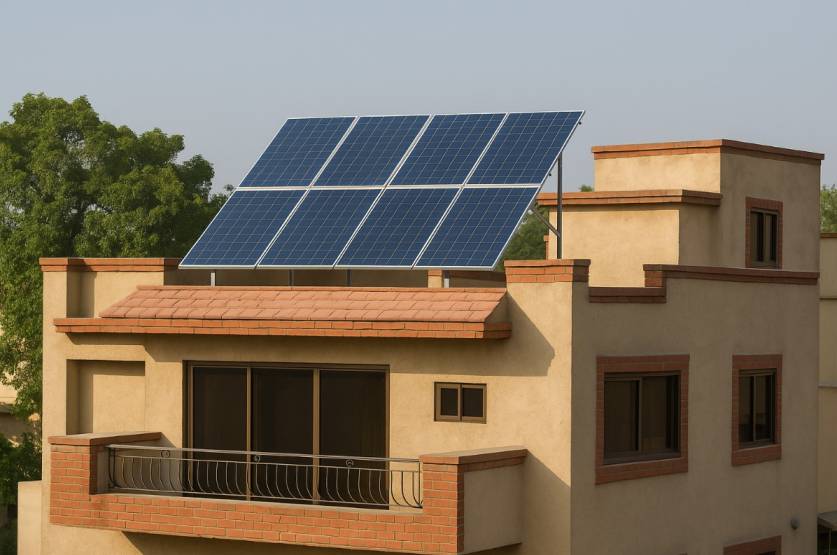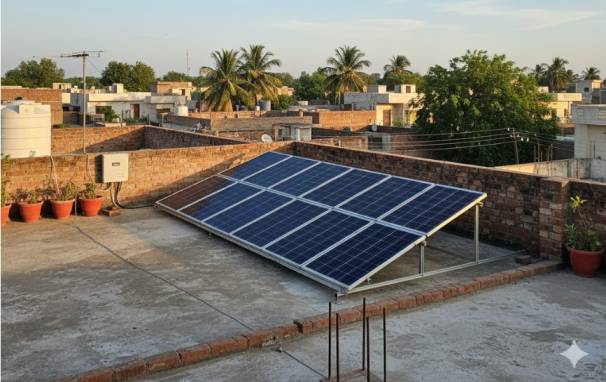1. The Problem: Rising Electricity Costs
In recent years, both Pakistan and India have experienced consistent increases in electricity prices, putting financial strain on households and businesses. The rising costs are driven by multiple factors including increasing fuel prices, transmission losses, and infrastructure maintenance costs. If you are Tired of Rising Electricity Bills? This is the Complete Solar Installation Guide to help you calculate your electricity load and to get the solar system installed on your house!
For many families, electricity bills have become one of the largest monthly expenses, especially during extreme weather conditions when air conditioning or heating is essential. This continuous upward trend in electricity tariffs has made solar energy an increasingly attractive alternative.
2. Solar Solution Options
Solar energy provides a sustainable solution to reduce dependency on grid electricity and lower monthly bills. There are three primary approaches to implementing solar power in your home or business:
3. Types of Solar Panels
Understanding the different types of solar panels available will help you make an informed decision:
Monocrystalline Solar Panels
These are made from single-crystal silicon, offering the highest efficiency rates (15-22%) and a longer lifespan. They perform better in low-light conditions but are typically the most expensive option.
Polycrystalline Solar Panels
Made from multiple silicon crystals melted together, these panels have efficiency rates of 13-16%. They are more affordable than monocrystalline panels but slightly less efficient and take up more space.
Thin-Film Solar Panels
These lightweight, flexible panels are made by depositing photovoltaic material on a substrate. While less efficient (10-13%) and requiring more space, they perform better in high temperatures and can be integrated into building materials.
How to Select the Best Solar Panel:
- Consider your available roof space – choose higher efficiency panels if space is limited
- Evaluate your budget – balance between cost and efficiency
- Check warranty terms – reputable manufacturers offer 25+ years performance warranty
- Review temperature coefficients – important in hot climates
- Verify certifications – look for IEC and UL certifications
4. Typical Appliance Power Consumption
Understanding how much electricity your appliances consume is the first step in sizing your solar system correctly. Below is a table showing typical wattage for common household appliances:
| Appliance | Typical Wattage | Average Daily Usage (Hours) | Estimated Monthly Cost* |
|---|---|---|---|
| LED Bulb | 10-15W | 6-8 | ₹30-50 / ₨40-70 |
| Ceiling Fan | 70-80W | 8-12 | ₹150-250 / ₨200-350 |
| Television (LED) | 80-150W | 4-6 | ₹120-200 / ₨160-280 |
| Refrigerator | 150-300W | 8-12 (cycling) | ₹300-500 / ₨400-700 |
| Desktop Computer | 200-300W | 4-8 | ₹200-400 / ₨270-530 |
| Washing Machine | 500-1000W | 1-2 | ₹100-250 / ₨130-330 |
| Water Pump | 500-1000W | 1-2 | ₹100-250 / ₨130-330 |
| Air Conditioner (1.5 Ton) | 1500-2000W | 6-10 | ₹1500-3000 / ₨2000-4000 |
| Electric Geyser | 2000-3000W | 1-2 | ₹400-800 / ₨530-1060 |
*Estimates based on average electricity rates in India (₹6-8/kWh) and Pakistan (₨8-11/kWh). Actual costs may vary.

5. Solar Energy Calculator
Use this calculator to estimate your daily electricity consumption and determine the appropriate solar system size for your needs.
Your Appliances
Select your appliances and their daily usage:
Your Solar Analysis
Energy Consumption
Total Daily Consumption: 0 kWh
Estimated Monthly Cost: 0
Solar System Recommendation
Based on your energy usage, we recommend a 0 kW solar system.
Estimated installation cost: 0
Estimated payback period: 0 years
Note: This calculation assumes:
- 5 peak sun hours per day (average in Pakistan/India)
- System efficiency of 80% (inverter & transmission losses)
- Current electricity rates: India ₹7/kWh, Pakistan ₨9/kWh
Battery Storage Calculator
How Solar System Sizing is Calculated
The formula used in our calculator is:
System Size (kW) = (Daily Consumption ÷ Peak Sun Hours) ÷ System Efficiency
Let us understand this for a hypothetical scenario where total Daily Consumption: 20.39 kWh, our tools suggests that 5.1 kW solar system should be deployed. Let’s break down this:
General Calculation and Considerations:
- Daily Consumption: 20.39 kWh
- Peak Sun Hours: 5 hours (average for Pakistan/India)
- System Efficiency: 80% (0.8)
Step-by-step calculation:
- Energy needed per sun hour = 20.39 kWh ÷ 5 hours = 4.078 kW
- Account for system losses = 4.078 kW ÷ 0.8 = 5.0975 kW
- Rounded to = 5.1 kW system
What This Means in Practice
1. Daily Energy Production
A 5.1 kW system in your location would produce:
- 5.1 kW × 5 sun hours × 0.8 efficiency = 20.4 kWh per day
This exactly matches your daily consumption of 20.39 kWh.
2. Physical System Size
- Typical solar panels: 400-550 watts each
- For 5.1 kW system: 12-13 panels (assuming 400W panels)
- Roof space needed: Approximately 75-85 sq. ft (7-8 sq. meters)
3. Real-World Considerations
Why we account for 80% efficiency:
- Inverter losses (5-10%)
- Temperature losses (10-15%)
- Dust/dirt on panels (2-5%)
- Wiring losses (1-3%)
Seasonal Variations:
- Summer: More than 5 sun hours → excess production
- Winter: Fewer than 5 sun hours → may need grid backup
- Monsoon: Reduced production → grid dependency
Is 5.1 kW Right for Your Situation?
For a Typical Household:
- Small family (2-3 people): 3-5 kW system
- Medium family (4-5 people): 5-7 kW system
- Large family + AC usage: 7-10+ kW system
Your 20.39 kWh/day consumption suggests:
- A fairly energy-intensive household
- Likely running 1-2 AC units regularly
- Multiple refrigerators or other high-consumption appliances
- Family of 4-6 people
Financial Implications
For a 5.1 kW system:
- Installation Cost: ₹255,000 – ₹355,000 (India) / ₨331,500 – ₨461,500 (Pakistan)
- Monthly Savings: ₹4,200 – ₹5,700 (India) / ₨5,500 – ₨7,400 (Pakistan)
- Payback Period: 4-7 years
Recommendation
A 5.1 kW system is well-sized for your needs because:
- It covers 100% of your current daily consumption
- Provides some buffer for future energy needs
- Is a common, cost-effective system size
- Works well with net metering if available
Consider going slightly larger (5.5-6 kW) if:
- You plan to add more appliances
- You want to charge an electric vehicle
- You have poor panel orientation/shading issues
Battery Selection Guide
1. Types of Batteries
Lithium-Ion (LiFePO4) – RECOMMENDED
- Depth of Discharge: 80-90%
- Lifespan: 5-10 years
- Efficiency: 95-98%
- Cost: Higher upfront, better long-term value
- Best for: Daily cycling, long-term savings
Lead-Acid (Flooded)
- Depth of Discharge: 50%
- Lifespan: 3-5 years
- Efficiency: 80-85%
- Cost: Lower upfront, higher replacement cost
- Best for: Budget systems, occasional use
Tubular Batteries
- Depth of Discharge: 60-70%
- Lifespan: 5-7 years
- Efficiency: 85-90%
- Cost: Moderate
- Best for: Reliable performance, medium budget
2. Battery Sizing Examples
For your 20.39 kWh daily consumption:
Scenario A: Basic Backup (8 hours)
- Nightly need: ~6.8 kWh
- Lithium battery: 8.5 kWh system (85 Ah @ 48V × 2 batteries)
- Cost: ~₹130,000
Scenario B: Full Night Backup (12 hours)
- Nightly need: ~10.2 kWh
- Lithium battery: 12.75 kWh system (265 Ah @ 48V × 3 batteries)
- Cost: ~₹195,000
Scenario C: Partial Backup (Critical loads only)
- Assume 40% of consumption at night: ~3.4 kWh
- Lithium battery: 4.25 kWh system (88 Ah @ 48V × 1 battery)
- Cost: ~₹65,000

6. How to Select a Solar Panel Company
Choosing the right solar installer is crucial for a successful solar energy system. Consider these factors:
Experience and Track Record
Look for companies with several years of experience and a proven track record of successful installations. Ask for references and case studies.
Certifications and Qualifications
Ensure the company has proper certifications from relevant authorities and that their technicians are trained and certified.
Quality of Components
Inquire about the brands of solar panels, inverters, and batteries they use. Reputable companies work with established manufacturers.
Warranty and After-Sales Service
Check what warranties are offered on both equipment and installation work. Good after-sales service is essential for long-term performance.
Financial Options
Some companies offer financing options or can guide you through available government subsidies and incentives.
Get Multiple Quotes
Always get at least three quotes from different companies to compare pricing, equipment quality, and service offerings.
7. Closing Remarks
Transitioning to solar energy is a significant decision that requires careful planning and consideration. While the initial investment may seem substantial, the long-term savings and energy independence make it a worthwhile consideration for households and businesses in Pakistan and India.
Start by accurately assessing your energy needs using our calculator, then research reputable solar companies in your area. With proper planning and the right installation partner, you can significantly reduce your electricity bills and contribute to a more sustainable future.
Next Steps:
- Use the calculator above to determine your energy needs
- Research solar installers in your area and get multiple quotes
- Explore financing options and government incentives
- Schedule consultations with at least three reputable companies
- Make an informed decision based on your budget and energy goals
